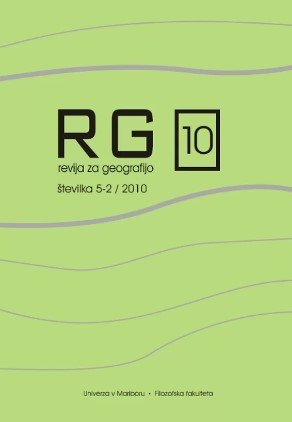Fighting for Survival - Planning and Development Issues in two European Rural Border Mid-Mountain Regions
DOI:
https://doi.org/10.18690/rg.5.2.4029Keywords:
marginal mid-mountain rural areas, spatial planning and mountain policy, agrarian landscape, Spain, Austria, Pyrenees, AlpsAbstract
The main aim of this article (the paper is included in the context of a research project funded by the Spanish Ministry of Science and Technology – code: SEJ-2006-15331-C02-02) is to further our understanding of two mountain rural areas occupying two distinct geographical environments: the Spanish Pyrenees and the Austrian Alps. I am particularly interested in examining the management practices that have been adopted as part of the public policies implemented in two mid-mountain regions - areas that do not have the same possibilities for development as those enjoyed by high-mountain environments. These places suffer structural problems resulting from low levels of agricultural competitiveness, accompanied by factors that impinge negatively on land use (which, in turn, condition their landscape management practices). Finally, I reflect on the differences between the two regions and their future possibilities.
Downloads
References
Bätzing, W. 2008: Die Schweiz und Österreich als «Alpenländer»? Geographische Rundschau, 60 (3), p. 4-13.
Benabent, M. 2005: Una visione panoramica dell’ordinamento del territorio in Spagna. Complessita e Sostenibilità, 6, p.16.
Bestandmann, C. 2007: Kärnterisch Laßnitz. Geschichte eines Dorfes und seiner Umgebung. Laßnitz bei Murau.
Čede, P. 1998: Kulturlandschaftswandel im mittelgebirge: fallbeispiel niedere gurktaler alpen. Österreich in Geschichte und Literatur, 42 (6), p. 379-390.
Groier, M., Hovorka, G. 2007: Innovativ bergauf oder traditionell bergab? Politik fur das osterreichische Berggebiet am Beginn des 21. Jahrhunderts. Vienna: Bundesalstalt fur Bergbauernfragen.
Lasanta, T. 1997: La transformación del paisaje en montaña media por la actividad agrícola en relación con las condiciones ambientales. In: García Ruiz, J. M., López García, P. (eds) Acción humana y desertificación en ambientes mediterráneos. Zaragoza: Instituto Pirenaico de Ecología, p. 145-172.
Lichtemberger, E. 1965: Das Bergbauerproblem in den österreichischen Alpen. Perioden und Typen der Entsiedelung. Erdkunde, 19, p.39-57.
Ojeda Rivera, J. F. 2004: El paisaje–como patrimonio– factor de desarrollo de las áreas de montaña. Boletín de la AGE, 38, p. 273-278.
Österreichische Raumordnungskonferenz, 2008: Zwölfter Raumordnungsbericht. Analysen und Berichte zur räumlichen Entwicklung Österreichs 2005-2007. Vienna, ÖROK.
Romero González, J. 2005: El gobierno de territorio en España. Balance de iniciativas de coordinación y cooperación territorial. Boletín de la AGE, 39, p. 59-86
Sabio Alcutén, A. 1997: Los montes públicos en Huesca (1859-1930). El bosque no se improvisa. Huesca: Instituto de Estudios Altoaragoneses.
Sancho, A. 2008: La Terreta (Ribagorça). Síntesi territorial i transformació del paisatge. Barcelona.
Serrano Martínez, J. M. 2005: El modelo territorial de la España autonómica. Recapi-tulación y perspectivas. Investigaciones Geográficas, 36, p. 81-102. https://doi.org/10.14198/INGEO2005.36.09
Soukup D., Türk R. 2003: Flechten der Murberge und der NW-Ausläufer der Gurktaler Alpen (Steiermark, Österreich). Fritschiana, p. 44.
Tremosa Palau, R. 1991: La demografia i l’economia de la clotada d’Areny (1900-1980). Un model per interpretar l’evolució del Prepirineu. Osca: Diputación de Huesca.
Verbindungsstelle der Bundesländer beim Amt der Niederösterreichische Landes-regierung, 1979: Raumordnungspraxis in den Bundesländern. Ausschnitte und Querschnitte. Vienna.
Downloads
Published
Issue
Section
License
Copyright (c) 2010 Alexis Sancho Reinoso

This work is licensed under a Creative Commons Attribution 4.0 International License.
